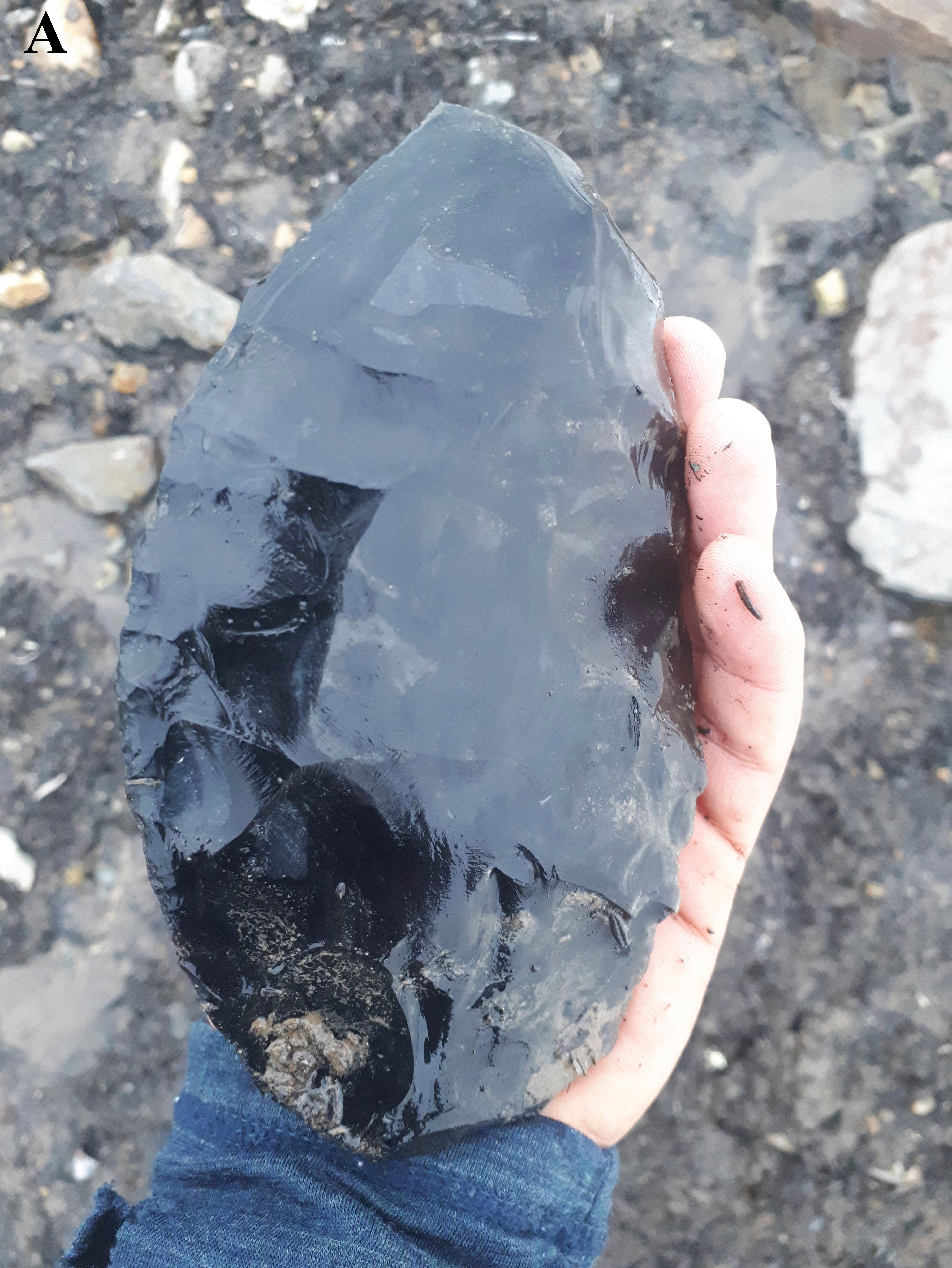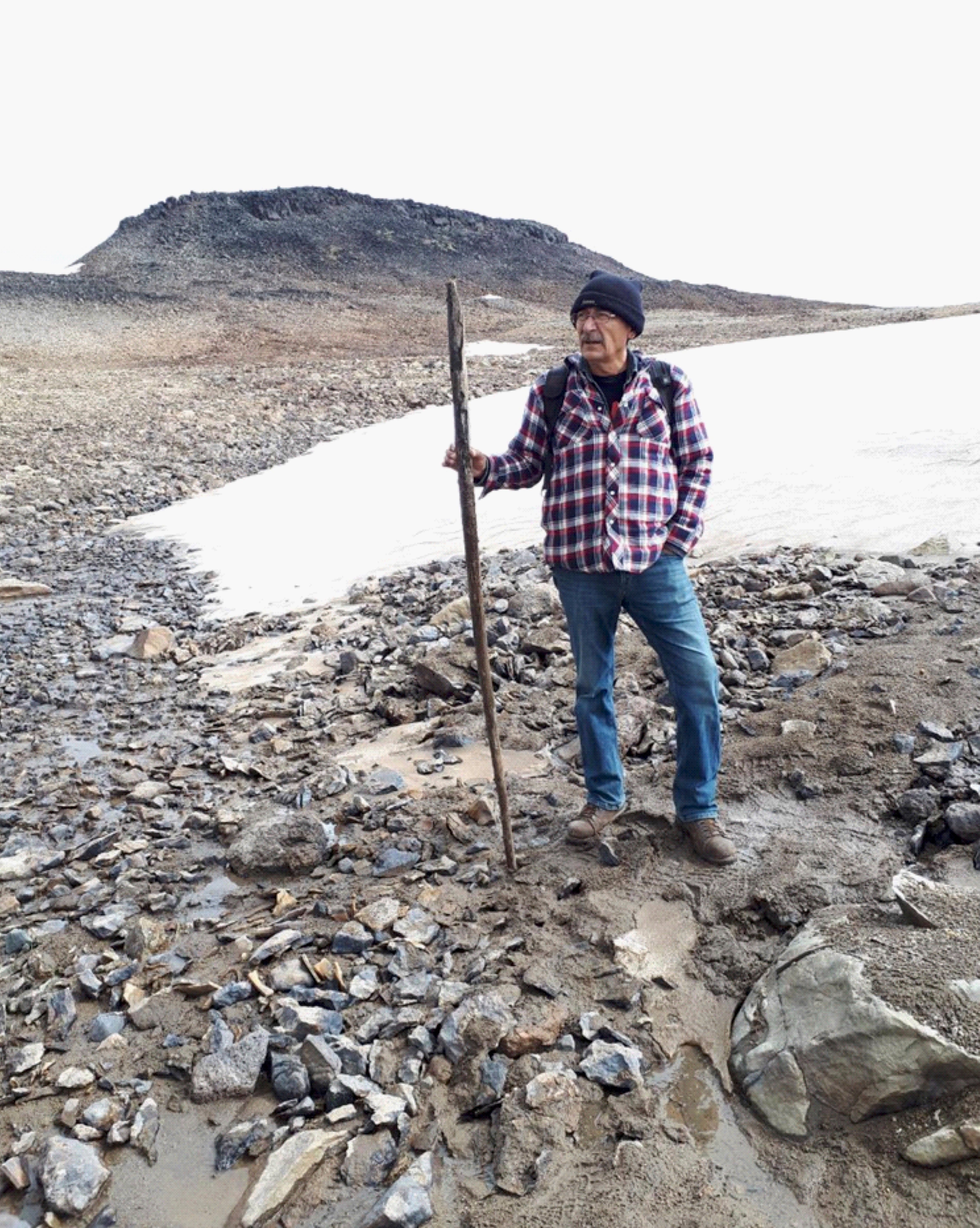Along with obsidian that dazzled scientists in Canada.
BY MEG ST-ESPRIT

One of nine ice patches released objects from 6200–5300 years ago. DUNCAN MCLAREN
NORTHERN CANADA IS KNOWN FOR its blustery weather, dramatic landscape, and plentiful ice. But with an unprecedented thaw in Canada’s Mount Edziza Provincial Park the past few years, objects began emerging from the ice.
Some of the manmade possessions are 7,000 years old, and they belonged to the Tahltan First Nations. Mount Edziza, a volcano located in northwestern British Columbia, has remained a significant hunting ground for the Tahltan nation for thousands of years. With this discovery, archaeologists are now able to gain more insight into what life was like for people here since around 5,000 B.C.

There were containers crafted from birch bark, antler ice picks, tools carved from bones, walking sticks, and even a stitched boot. Among the artifacts discovered were also tools fashioned from obsidian, the black glass created by lava flows. Many others are made from materials such as leather, wood, and bone.
It’s a rare find, according to Duncan McLaren, lead archaeologist on the project. “There was such a high density of artifacts. We knew there was obsidian, but we didn’t realize until we had done this project that there were all these organic artifacts that were preserved around the obsidian,” he explains. McLaren says his team was initially blinded by the sparkling glass, but soon learned to train their eyes to find other artifacts.
These objects were so well-preserved and undisturbed in part due to their remote location. “This keeps visitor numbers low and also aids in the protection and preservation of artifacts,” says David Karn, commenting on behalf of the Ministry of Environment.

Within nine patches of ice, 56 objects were recovered overall. “Archeologists were able to carbon-date the organic materials, such as the digging sticks and leather items,” says Karn. “Carbon dating provides researchers with an idea of when the tools were made and how they were used.”
Of particular interest to researchers are two bark containers that are believed to be around 2,000 years old. One has detailed stitching along one edge that is still largely intact. The second container is more unique. Sticks are stitched to the inside of the container to reinforce the framework, creating a basket that could bear heavier loads.
The team also found an ice pick, carved from an antler, or ede’ in Tahltan, that was dated at around 5,000 years old—a useful tool for Indigenous residents of a cold, snowy region. Though one end appears to be broken, researchers were able to see the antler had been intentionally sharpened and shaped with a handle for ease of use.

The remains of a shoe, which McLaren describes as a moccasin-like boot, consists of complicated stitching and flaps—further evidence that early Tahltan hunters created complex items to thrive in the harsh climate of the region. Of note, says McLaren, is that the design hasn’t changed much through the millenia. “It is very similar to the types people have been wearing historically through the years,” he notes.
As to why these objects surfaced now after millennia encapsulated in ice, researchers attribute it to low snowpack in the region over several years. “It took us over five years to get the funding for this project,” says McLaren, who first began excavating the area in July of 2019. Now that the objects have been recovered, the team is working on study and preservation; the ancient items are very fragile. While housed in a climate-controlled provincial museum at the moment, McLaren says plans are underway to create a museum site in Tahltan territory that is capable of storing the artifacts safely.

The research team worked in conjunction with several other organizations, including the Obsidian Discoveries Tahltan Tene Mehodihi Youth Group Hike. Tene mehodihi translates to “the trail we know,” and the land-based education program seeks to educate Tahltan youth about the history of their nation through exploratory experiences such as this one.
“The findings further identify the archeological and cultural significance of the land encompassed within Mount Edziza Park,” says Karn. The Tahltan Central Government was not available for interview at this time, but tourism director Alex Buri says visitors should be aware of several things: Mount Edziza is extremely remote with a harsh climate, and visitors should consider hiring a local guide for exploration. The region is also extremely significant to the Tahltan First Nations people. Visitors should be respectful, not take any objects, and remember that artifacts are protected under provincial law.
No comments:
Post a Comment